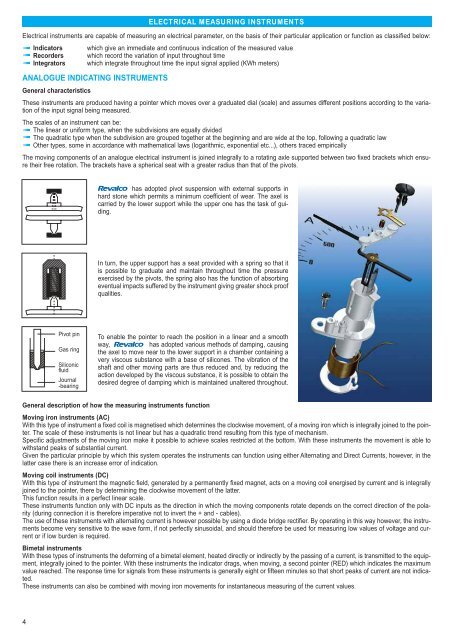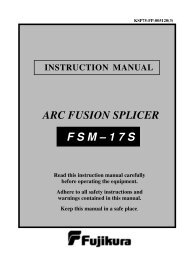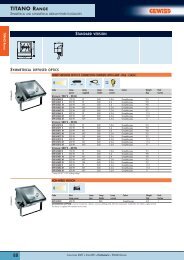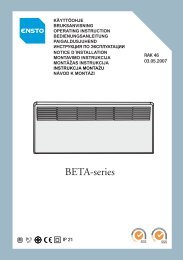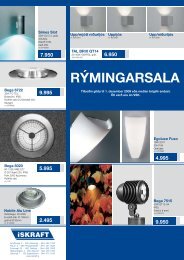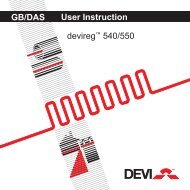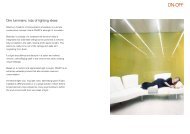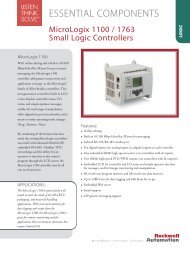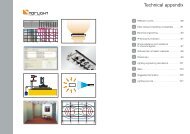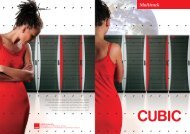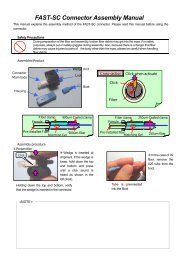analogue instruments
analogue instruments
analogue instruments
Create successful ePaper yourself
Turn your PDF publications into a flip-book with our unique Google optimized e-Paper software.
Electrical <strong>instruments</strong> are capable of measuring an electrical parameter, on the basis of their particular application or function as classified below:<br />
Indicators which give an immediate and continuous indication of the measured value<br />
Recorders which record the variation of input throughout time<br />
Integrators which integrate throughout time the input signal applied (KWh meters)<br />
ANALOGUE INDICATING INSTRUMENTS<br />
ELECTRICAL MEASURING INSTRUMENTS<br />
General characteristics<br />
These <strong>instruments</strong> are produced having a pointer which moves over a graduated dial (scale) and assumes different positions according to the variation<br />
of the input signal being measured.<br />
The scales of an instrument can be:<br />
The linear or uniform type, when the subdivisions are equally divided<br />
The quadratic type when the subdivision are grouped together at the beginning and are wide at the top, following a quadratic law<br />
Other types, some in accordance with mathematical laws (logarithmic, exponential etc...), others traced empirically<br />
The moving components of an <strong>analogue</strong> electrical instrument is joined integrally to a rotating axle supported between two fixed brackets which ensure<br />
their free rotation. The brackets have a spherical seat with a greater radius than that of the pivots.<br />
has adopted pivot suspension with external supports in<br />
hard stone which permits a minimum coefficient of wear. The axel is<br />
carried by the lower support while the upper one has the task of guiding.<br />
In turn, the upper support has a seat provided with a spring so that it<br />
is possible to graduate and maintain throughout time the pressure<br />
exercised by the pivots, the spring also has the function of absorbing<br />
eventual impacts suffered by the instrument giving greater shock proof<br />
qualities.<br />
Pivot pin<br />
Gas ring<br />
Siliconic<br />
fluid<br />
Journal<br />
-bearing<br />
To enable the pointer to reach the position in a linear and a smooth<br />
way,<br />
has adopted various methods of damping, causing<br />
the axel to move near to the lower support in a chamber containing a<br />
very viscous substance with a base of silicones. The vibration of the<br />
shaft and other moving parts are thus reduced and, by reducing the<br />
action developed by the viscous substance, it is possible to obtain the<br />
desired degree of damping which is maintained unaltered throughout.<br />
General description of how the measuring <strong>instruments</strong> function<br />
Moving iron <strong>instruments</strong> (AC)<br />
With this type of instrument a fixed coil is magnetised which determines the clockwise movement, of a moving iron which is integrally joined to the pointer.<br />
The scale of these <strong>instruments</strong> is not linear but has a quadratic trend resulting from this type of mechanism.<br />
Specific adjustments of the moving iron make it possible to achieve scales restricted at the bottom. With these <strong>instruments</strong> the movement is able to<br />
withstand peaks of substantial current.<br />
Given the particular principle by which this system operates the <strong>instruments</strong> can function using either Alternating and Direct Currents, however, in the<br />
latter case there is an increase error of indication.<br />
Moving coil <strong>instruments</strong> (DC)<br />
With this type of instrument the magnetic field, generated by a permanently fixed magnet, acts on a moving coil energised by current and is integrally<br />
joined to the pointer, there by determining the clockwise movement of the latter.<br />
This function results in a perfect linear scale.<br />
These <strong>instruments</strong> function only with DC inputs as the direction in which the moving components rotate depends on the correct direction of the polarity<br />
(during connection it is therefore imperative not to invert the + and - cables).<br />
The use of these <strong>instruments</strong> with alternating current is however possible by using a diode bridge rectifier. By operating in this way however, the <strong>instruments</strong><br />
become very sensitive to the wave form, if not perfectly sinusoidal, and should therefore be used for measuring low values of voltage and current<br />
or if low burden is required.<br />
Bimetal <strong>instruments</strong><br />
With these types of <strong>instruments</strong> the deforming of a bimetal element, heated directly or indirectly by the passing of a current, is transmitted to the equipment,<br />
integrally joined to the pointer. With these <strong>instruments</strong> the indicator drags, when moving, a second pointer (RED) which indicates the maximum<br />
value reached. The response time for signals from these <strong>instruments</strong> is generally eight or fifteen minutes so that short peaks of current are not indicated.<br />
These <strong>instruments</strong> can also be combined with moving iron movements for instantaneous measuring of the current values.<br />
4


